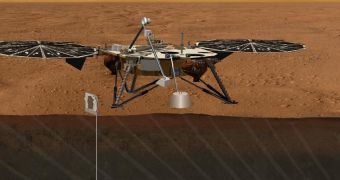The American space agency is currently in the process of evaluating its options for a major, 2016 space exploration mission, after having selected three of the most promising proposals submitted by experts.
At this point, the three research teams that proposed the investigations will receive $3 million each. The funds will be used to elaborate on the concept phase of the proposed missions, and to detail preliminary design studies and analyses even further.
In 2012, after the teams submit their studies, and NASA evaluates them again, a single mission will be selected for funding and further development. According to experts at the space agency, a spacecraft carrying the mission will then launch in 2015.
Officials also add that the robotic explorer will have a cost cap of $425 million, adjustable for inflation. The cost will obviously not include contracting the delivery system for the mission, they add.
“NASA continues to do extraordinary science that is re-writing textbooks. Missions like these hold great promise to vastly increase our knowledge, extend our reach into the solar system and inspire future generations of explorers,” said NASA Administrator Charles Bolden.
During the new round of proposals, which opened in June 2010, NASA received 28 submissions, each of which had its ups and downs. The three finalists were selected after a careful analysis of their traits.
The first finalist is the Geophysical Monitoring Station (GEMS), a lander developed specifically for the purpose of understanding the interior structure and composition of the Martian interior.
The principal investigator for the lander will be scientist Bruce Banerdt, who is based at the NASA Jet Propulsion Laboratory. The JPL would also manage the mission, if it gets approved for development.
“We want to know more about how the pieces that formed planets came together in the first place, and about the changes that took place afterwards. This would be a mission to understand the formation and evolution of terrestrial planets,” the JPL expert says.
The second accepted proposal is the Titan Mare Explorer (TiME). This mission is also a lander, but one that will descend, and then made to float, on the liquid hydrocarbon oceans of Saturn's moon Titan.
Such a mission would represent the first time that a spacecraft is sent to explore an ocean that is not on Earth. Titan is shaping up to be one of the most interesting targets of exploration in the solar system. Even if TiME is not selected, a mission will eventually be sent there.
In the third proposal, experts at the NASA Goddard Space Flight Center, in Greenbelt, Maryland, would manage the Comet Hopper spacecraft. This probe would land on a comet multiple times, and study the evolution of such space bodies as it does so.
“This is high science return at a price that's right. The selected studies clearly demonstrate a new era with missions that all touch their targets to perform unique and exciting science,” concludes the director of the NASA Planetary Science Division, Jim Green.

 14 DAY TRIAL //
14 DAY TRIAL //